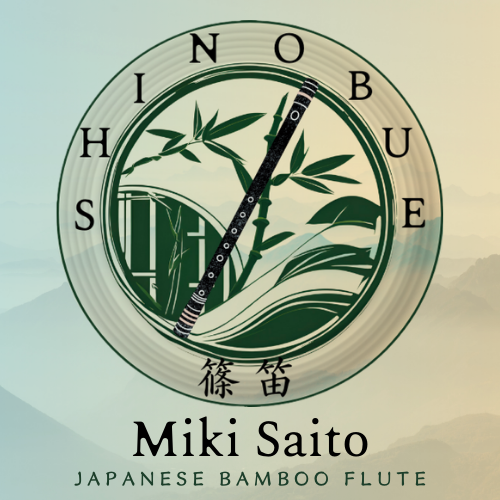Answering your shinobue buying questions!
Buying a shinobue online can be an exciting adventure, but it does come with some risks! 🫢To make the best choice, it’s important to arm yourself with knowledge. I’ve gathered some of the most common questions I receive, and I hope my answers will help you feel more confident and informed in your purchase.
"Where can I buy a shinobue?"
Here are several ways to purchase shinobues.
The IDEAL scenario is to visit the shinobue makers' shops in Japan, play some of their shinobues, and buy the one you like. Many serious shinobue players make long trips to do so.
Play shinobues at retail stores in Japan and buy the one you like. They let you try them!
3. Buy one through your shinobue teacher. This is another common way people buy shinobue in Japan.
4. Buy one from online stores like Taiko Center and Mejiro. My first shinobue came from Taiko Center. I have never bought one from Mejiro but I've heard people who have done it.
5. Buy one from Amazon, Etsy, or eBay. I don't recommend them because I am not sure if the sellers are knowledgeable about shinobue.
6. Buy one on my website, saitomusic.com. I only sell shinobues that I love and trust. Prices, fees, and shipping are clearly listed in USD, and you can email me to ask any questions before and after.
Unfortunately, many shinobues available in retail (in-person or online) are leftovers that weren't chosen by serious shinobue enthusiasts at the maker's shop.
This is why purchasing directly from shinobue makers or obtaining one through your teacher is the best option. This was not possible for most of us until I began offering the Shoji shinobues that Bunta sensei had personally tested and approved. Additionally, I sell Suzuki plastic shinobues, as they are produced from molds, ensuring consistent quality, unlike bamboo shinobues, which can vary significantly.
"What do you think of xxx brand? Do you recommend them?"
The brand of shinobue you prefer is highly personal, much like choosing a favorite car brand. I love my Toyota, but you may well buy and love others.
It may be helpful if I created a brand comparison video, but unfortunately, I cannot because...
The only shinobues I can play well are the ones I'm used to playing.
I play Shoji all the time because my teacher, Bunta sensei, plays them. I have other brands that I bought out of curiosity, but I don't play them all the time, so I don't sound good on them. But that does NOT mean other brands are bad!! I'm just not used to playing them.
Imagine if I made a brand comparison video and said, "Here is what Rippei shinobue sounds like." and played it badly because I'm not used to it?? That would be terribly unfair to Rippei Shinobues!!!!
*This is not Mr. Rippei. 😄
I can only speak from my experience that I recommend Shoji and Suzuki, but that is just one person's opinion. Solution: Let's grow our shinobue community and share our experiences on various brands!!
"Which hon choshi should I buy?"
The most commonly used shinobue hon choshis are 3, 6, 7 and 8. However, avoid buying a 3 hon choshi if you are a beginner. It's a bigger flute and harder to play well.
Many beginners find that the sound of the 6 hon choshi is richer and deeper than that of the 7 or 8. But 8 hon choshi might be a better choice if you have small hands. Also, 8 might be a good choice if you plan to play with other instruments like piano since it's tuned to C major. Additionally, the 8 hon choshi might be a good choice for playing with taiko groups because it has a higher sound that might make it easier to carry over taiko drums.
While you might want to purchase the 8 hon choshi to play "A Life Sent On," remember that you might not be able to play that song for about a year. Therefore, you may find it more enjoyable to start with a 6 or 7 hon choshi. In terms of pricing, generally, the larger the flute (indicated by a lower hon choshi number), the more expensive the shinobue will be.
"Should I get Do re mi, Uta, Hayashi or Koten style?"
If you are a beginner without a teacher, I recommend starting with either the Do Re Mi style or the Uta style. The Do Re Mi style is generally easier to tune to the pitch of the piano or audio track you are using. On the other hand, the Uta style may be more comfortable for your fingers. Many Uta shinobues can closely match the Western musical scale. If you want to learn more about the differences between these terms, I suggest watching this video!
"I bought a shinobue, and it cracked. Is this common?"
This is more common than you think. Since Japan is a very humid country and most houses do NOT have central air, bamboo shinobues suffer in dry environments.
This is another reason why you might want to seriously consider getting a non-bamboo shinobues, especially if you are just starting out. It is less expensive than bamboo flutes, too.
Then if you decide you really like playing shinobues, start saving up money and get a shinobue with thick coating and/or binding. They are much less likely to crack.
These shinobues by Wako have thick coating and binding.
Either way, if you own a bamboo flute, keep the humidity of your room between 40 and 60%. Measure your humidity with a hygrometer and if it's lower than 40%, use a humidifier. Check out my favorite hygrometer and humidifiers at my Amazon storefront! This is an easy way to protect your shinobue and support my work!
